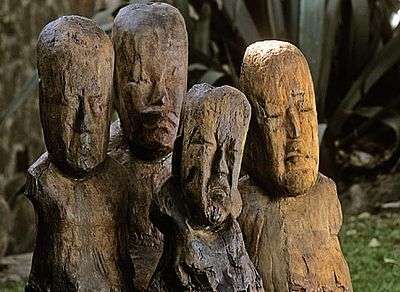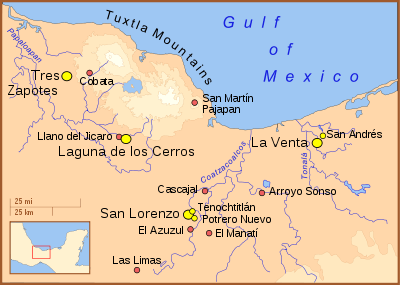El Manatí
| Olmec Culture – Archaeological Site | ||
 Four of the preserved wooden busts. Note the resemblance to this jade figurine. | ||
| Name: | El Manatí | |
| Type | Mesoamerican archaeology | |
| Location | Hidalgotitlán, Veracruz | |
| Region | Mesoamérica (México) | |
| Coordinates | 17°37′21″N 94°38′30″W / 17.622427°N 94.641552°WCoordinates: 17°37′21″N 94°38′30″W / 17.622427°N 94.641552°W | |
| Culture | Olmec | |
| Language | ||
| Chronology | 1600–1200 BCE.C. | |
| Period | Mesoamerican Preclassical | |
| Apogee | ||
| INAH Web Page | Non existent | |
El Manatí is an archaeological site located approximately 60 km south of Coatzacoalcos, in the municipality of Hidalgotitlán 27 kilometers southeast of Minatitlan in the Mexican state of Veracruz. El Manatí was the site of a sacred Olmec sacrificial bog from roughly 1600 BCE until 1200 BCE. It is likely that this site was used for ritual ceremonies which included offerings of wooden sculptures, rubber balls, ceremonial axes, and other items, including the bones of infants – all found in an excellent state of preservation in the muck. Most of the wooden sculptures are busts created in the "elongated man" style and are the oldest wooden artifacts yet found in Mexico.[1] The rubber balls are also the earliest such items yet discovered[2] and were possibly used in the Mesoamerican ballgame.
The Olmec Culture
The Olmec were a Pre-Columbian civilization living in the tropical lowlands of south-central Mexico, close to the border between the modern-day states of Veracruz and Tabasco. The Olmec flourished during Mesoamerica's Formative period, dating roughly from as early as 1500 BCE to about 400 BCE. Pre-Olmec cultures had flourished in the area since about 2500 BCE, but by 1600-1500 BCE Early Olmec culture had emerged centered around the San Lorenzo Tenochtitlán site near the coast in southeast Veracruz.[3] They were the first Mesoamerican civilization and laid many of the foundations for the civilizations that followed.[4] Among other "firsts", there is evidence that the Olmec practiced ritual bloodletting and played the Mesoamerican ballgame, hallmarks of nearly all subsequent Mesoamerican societies.
The site
El Manatí is located at the foot of Cerro Manatí, some 15 km (9.3 mi) southeast of the major Olmec center of San Lorenzo Tenochtitlán. It is notable among Olmec sites for the absence of contemporaneous local ceremonial or domestic architecture.
Archaeologists have identified three separate phases of deposits at El Manatí:
- Manatí A Phase (ca. 1700 - 1600 BCE)
- Manatí B Phase
- Macayal Phase (ca. 1040 BCE ± 150 years). The wooden busts were all found in this later phase.
El Manati may have been chosen as a sacred place because of one or more of its natural features:[5]
- The presence of a natural spring, often a feature of Mesoamerican sacred sites.
- The presence of red pigment, likely hematite, which symbolized blood.
- Its location at the foot of a hill, Cerro Manatí.[6] Many early Mesoamerican sites, including Chalcatzingo, Teopantecuanitlan, and Las Bocas, were situated east or west of a prominent hill.[5]
Discoveries

Many artifacts have been found, among them wooden busts and rubber balls.
Wooden Busts
Of particular note are 37 wooden busts or sculptures recovered from the bogs in 1989 by INAH archaeologists, during the third excavation phase at El Manatí.[7][8] These busts were unusually well-preserved, owing to the anaerobic conditions of their interment and a stable water temperature that impeded microbial decay.[8] Samples from two of these busts produced Carbon-14 dating results equivalent to a date of around 1200 BCE.[8] Carved from the wood of ceiba and jobo trees, almost all of the busts had been ritually buried and wrapped in mats (petates) made from vegetable fibers—the earliest evidence of funeral wrappings in Mexico.[8] The number of busts interred at or around the same time has led the INAH researchers to speculate that some widespread calamity, such as flood or prolonged drought, encouraged the ancient community to increase their offerings made in supplication to the mountain deities.[8]
Despite the obviously stylized shape of the head, researchers suggest that, due to their individual expressions, the busts depicted actual persons.[9] The wooden busts were usually accompanied by other objects. For example:
- Sculpture 1 was associated with a wooden staff and a dark green ax (celt).
- Sculpture 2 was associated with a large obsidian flake, tied bundles of leaves and plants, a hematite ball, a pile of sandstone rocks "common to a number of other sculptures,"[10] as well as fragments of human infant bones. Nearby to its east was the skeleton of an infant.
- Sculptures 5, 6, & 7 were interred as a group, each laid on their sides in a triangle, facing inward. These sculptures were associated with bundles of plant material and were covered with a mat. An incomplete wooden staff and an infant cranium were associated with this burial.
Some of these heads were stolen and later found in Germany in the hands of archaeological object traffickers.[11]
Rubber Balls
Twelve rubber balls associated with axe offerings were found El Manatí in 1989. Their surprisingly excellent state of preservation led archeologists to suspect that the balls had received a vulcanization type process, and it was found that the balls were made of two types of vulcanized latex.[12]
Ceremonial axes
In addition to the dozen rubber balls and 37 wooden busts, excavation has turned up many jadeite ceremonial axes (celts), pottery, greenstone beads arranged in clusters (likely once two separate necklaces), "baby-face" figurine fragments, carved wooden staffs, ritual obsidian knives (with no evidence of use), bones of newborn or unborn infants, and human and animal bone fragments. Most of these objects within the bog were found to be carefully arranged rather than haphazardly deposited, pointing to a sacred sacrificial intent.
Infant bones
The bones of the newborn or unborn infants consisted of some whole skeletons as well as dismembered femurs and skulls. These remains are particularly intriguing since they point to the possibility of human sacrifice, a ritual without direct evidence in the Olmec archaeological record. The infant remains are each associated with, and subordinate to, the burial of a wooden bust. It is not known how the infants died.[13]
Cocoa traces
On July 30, 2008, INAH reported that testing of residues found in a ceramic container in El Manatí, Veracruz, dating from approximately 1750 BCE (at least between 1900 to 900 BCE), show that the container contained a cocoa drink base probably consumed by the elite of the site.[14]
The ceramic vessel, which has slightly divergent cylindrical walls, a flat bottom, black spots and a red slip on its bottom, was associated with other sumptuary objects.[14] It is believed that this type of vessel was used for drinks such as "chicha" (maize beer), chocolate, and atole preparations which were consumed only by priests or other people of high social prestige.[14] Content verification tests yielded the presence of Theobromine, an essential cocoa component; chromatography and UV tests detected ions of cocoa's chemical components. This evidence predates other evidence found in Mayan areas of Belize and Puerto Escondido Honduras.[14]
Olmec technology
The Olmec knew how to produce rubber and various uses of it, and probably had technological processes for vulcanization and for waterproofing with tar.[15]
After multiple studies by several specialists, it has been established that to create the rubber balls, the Olmecs mixed latex rubber (Castilla elastica) with latex from the flowering vine Ipomoea alba, which is farmed in tropical regions of Mexico and contains latex sulphides.[15]
The chemical reaction produced by mixing the two allows vulcanization.[15]
The Olmecs obtained rubber or ulli by cutting an incision in the tree for the exuded latex, which in its natural state is a sticky milky fluid and when dry is very fragile and will not retain a form.[15]
The Ipomoea alba was crushed and, in liquid form, mixed in a container with the latex. When this mixture solidifies, it forms a white mass and can be used to form balls.[15]
There were probably two techniques used for making the balls. The first was to spread the rubber on a flat surface, let it dry and cut it into small strips. The second method was to cook the rubber and then shape it into a ball: this required high heat or vulcanization.[15]
See also
- Sacred Cenote - a natural spring and similar Maya offering site
Notes
- ↑ Ortíz and Rodríguez (1999, p.225)
- ↑ Hosler et al. (1999)
- ↑ Diehl, Richard A. (2004). The Olmecs : America's First Civilization. London: Thames and Hudson. pp. 9–25. ISBN 0-500-28503-9.
- ↑ See Pool, p. 2. Although there is wide agreement that the Olmec culture helped lay the foundations for the civilizations that followed, there is disagreement over the extent of the Olmec contributions, and even a proper definition of the Olmec "culture". See Olmec influences on Mesoamerican cultures for a more in depth treatment of this question.
- 1 2 Rodríguez and Ortíz (1997, p.93)
- ↑ Cerro Manatí is a salt dome.
- ↑ After the wooden heads were excavated they were symbolically baptized and given personal names, following a petition to INAH by locals from the nearby Macayal community, in order to "expel the demons" (pues había que quitarles el diablito).
- 1 2 3 4 5 "="Enterramiento masivo en el cerro El Manatí"" [Mass burial in cerro El Manati]. INAH Bulletins (in Spanish). Mexico. July 16, 2008. Retrieved Sep 2010. Check date values in:
|access-date=(help) - ↑ See for example Diehl (2004, p.45); also Ortíz and Rodríguez (1999, p.248), who comment: "the individuality of the busts could indicate that they were representations of chiefs, rulers, or persons who achieved a high level of prestige, leading to an attempt to immortalize them with images."
- ↑ Ortíz and Rodríguez (1999, p.238)
- ↑ Aguilar, Julio (June 25, 2008). "Se desconoce la magnitud del saqueo en Cerro Manatí, INAH guarda silencio sobre su autenticidad" [The magnitude of the looting in Cerro Manatí is unknown: INAH keeps quiet about its authenticity]. El Universal (in Spanish). Mexico. Check date values in:
|access-date=(help); - ↑ "Los olmecas inventaron el proceso de vulcanización" [The Olmecs invented the vulcanization process]. Aztlanvirtual.com e INAH (in Spanish). August 4, 2008. Retrieved Sep 2010. Check date values in:
|access-date=(help) - ↑ Ortíz and Rodríguez (1999, p.249)
- 1 2 3 4 "El Manatí, Veracruz - Formative Period Vessel (ca. 1750 BC) Containing Cacao-based Beverage Identified". Ancient Mesoamerica. July 30, 2008. Retrieved Sep 2010. Check date values in:
|access-date=(help) - 1 2 3 4 5 6 "Proceso de vulcanización de más de 3 mil 500 años" [Vulcanization Process of more than 3500 years] (in Spanish). Bitacora, semanario cultural. July 22, 2008. Retrieved Sep 2010. Check date values in:
|access-date=(help)
References
- Diehl, Richard (2004). The Olmecs: America's First Civilization. Ancient peoples and places series. London: Thames & Hudson. ISBN 0-500-02119-8. OCLC 56746987.
- Hosler, Dorothy; Sandra Burkett; Michael Tarkanian (June 18, 1999). "Prehistoric Polymers: Rubber Processing in Ancient Mesoamerica". Science. Washington, DC: American Association for the Advancement of Science. 284 (5422): 1988–1991. doi:10.1126/science.284.5422.1988. OCLC 207960606. PMID 10373117.
- INAH (Instituto Nacional de Antropología e Historia) (July 16, 2008). "Enterramiento masivo en el cerro El Manatí". Boletines. INAH. Retrieved 2008-07-30. (Spanish) (English)
- Ortíz C., Ponciano; María del Carmen Rodríguez (1999). "Olmec Ritual Behavior at El Manatí: A Sacred Space" (PDF). In David C. Grove and Rosemary A. Joyce (eds.). Social Patterns in Pre-Classic Mesoamerica: A Symposium at Dumbarton Oaks, 9 and 10 October 1993 (PDF online reproduction) (Dumbarton Oaks etexts ed.). Washington, DC: Dumbarton Oaks Research Library and Collection. pp. 225–254. ISBN 0-88402-252-8. OCLC 39229716.
- Rodríguez, Ma. del Carmen; Ponciano Ortíz C. (1997). "Olmec Ritual and Sacred Geography at Manatí". In Barbara L. Stark and Philip J. Arnold III (eds.). Olmec to Aztec, Settlement Patterns in the Ancient Gulf Lowlands. Tucson: University of Arizona Press. pp. 68–95. ISBN 0-8165-1689-8. OCLC 36364149.